A simple mention of the Pontiac brand forces tears into the eyes of many American car aficionados. One of the most beloved GM divisions served Americans for almost 85 years before becoming collateral in company’s bailout a few years ago. Although Pontiac disappeared abruptly, its arrival in 1926 was much more gradual. It was introduced as Oakland division’s companion marque. The same way LaSalle was Cadillac’s companion marque, Marquette was Buick’s or Viking used to be Oldsmobile’s. In a peculiar turn of events, Oakland was actually survived by Pontiac who absorbed Oakland’s models into its own lineup coming 1931 and onset of the great depression. Pontiac was the only companion marque to survive its parent division. As such, classic Pontiac cars got a chance that many discontinued brand’s models didn’t.
During Pontiac’s eight and a half decade long tenure, the division offered some extremely popular nameplates. The Pontiac Firebird Trans Am, GTO, and Grand Prix, for instance, were some of the most popular American cars available back in the day. Then, there were the likes of car models such as the Pontiac Aztek, Le Mans, and even Fiero which messed up with Pontiac’s reputation. Yet, people still remember them for their role in destroying the automaker. This time, however, we’ll focus on those forgotten Pontiacs that probably deserved better. Cars that never lingered for long, and left the stage before they were given the chance to make an impact.
Any list of Pontiac car models will include the obvious hard hitters like the Trans Am, and memorable muscle cars, but we’re here to look at the more obscure models that tend to be overlooked. If you’re looking for really modern-ish models like the Pontiac Solstice, and Pontiac Vibe, or really weird creations like the Pontiac Trans Sport, then prepare to be disappointed: we’re here to look a the classic Pontiac sports car models that time forgot!
The Old Pontiac Models That Everyone Forgets Existed!
1970-1971 GT-37

You might have forgotten that GT-37 ever existed because it wasn’t exactly a model on its own. The GT-37 was actually an affordable appearance and handling package available for a short time on two different intermediate A-body Pontiacs. It was introduced in 1970, and all Pontiac Tempest owners could have ordered it for $198. All who bought the entry-level T-37 hardtop coupe introduced mid year, that is. For just shy of $200, Pontiac offered Rally II wheels, white letter tires and striping from the ’69 GTO The Judge. Handling bit of the package included heavy-duty suspension, dual exhausts, and a floor-mounted 3-speed manual with a Hurst shifter. Hood-locking pins completed the package.
Of course, Tempest would disappear that very same year, but GT-37 would go on for another year. On Pontiac LeMans this time. LeMans actually took over Pontiac’s intermediate segment with T-37 serving as entry-level model. Pillared coupe yet again became a home to GT-37 package, but performance left a lot to be desired. 400 cu in V8, which wasn’t GTO-exclusive any more, delivered 265 horsepower with 2-barrel carb or 330 hp in 4-barrel setup for 1970. Figures fell to 215 and 300 ponies respectively, the following year. In similar fashion, 455 cu in V8 became available in 1971. Basic 4-barrel version of the strongest Pontiac V8 generated 325 ponies, while HO option raised 335 horses.
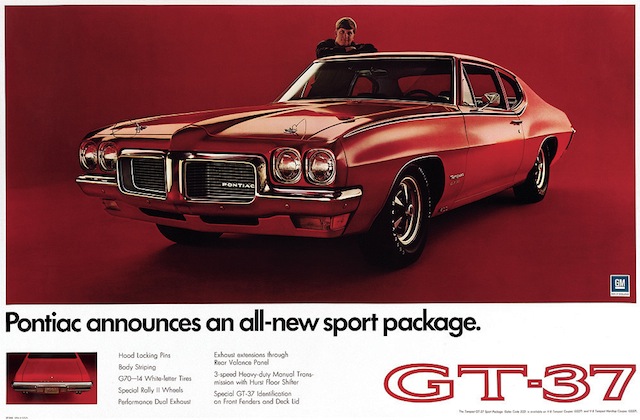
350 cu in V8 was standard GT-37 engine for both model years, and most of them were ordered with one. Very few people ordered the 455. Only 15 were 4-barrel models, while 54 people went home with the HO option.
GT-37 disappeared in theory for 1972, but LeMans Sport took over. But why was GT-37 introduced in the first place? It was actually John Z. DeLorean’s answer to 1967 Plymouth Roadrunner – a sub $3,000 muscle car that anyone could have afforded. It arrived 3 years later because DeLorean didn’t want it to be limited to 350 cu in V8. As already mentioned, larger displacement mills were exclusive to the GTO, and 400 cu in was only unshackled in 1970. The Pontiac GTO Judge became the first supercar born out of that idea, but it was much more expensive than first anticipated. It’s one of the most overlooked Pontiac models ever made.
1967-1970 Executive

Sure, every Pontiac fan remembers the Catalina and Bonneville full-size B-body models of the late sixties and beyond. But for a brief period between 1967 and 1970, they were joined by the Pontiac Executive. Executive itself was derived from long-serving Pontiac Star Chief which was renamed Star Chief Executive in 1966. The very next year, Star Chief name was withdrawn completely, leaving the Executive on its own.
Pontiac Executive shared Bonneville’s longer 124-inch wheelbase, but didn’t get its wealth of amenities. As far as trim and equipment go, Executive actually resembled a more affordable Catalina. It also got Catalina’s mechanical bits such as standard 3-speed column-mounted manual trans and 265-horsepower 400 cu in V8 engine. However, most people decided to go with optional 3-speed TH-400 auto transmission. There was another option in 4-speed floor-mounted manual with Hurst shifter for 1967 and 1968, while the job of being optional engine fell to 428 cu in V8. It developed 375 horsepower in base, and 390 ponies in HO form. For the last 1970 model year, 455 cu in with 370 horsepower became the optional engine.
Slotting neatly between Catalina and Bonneville, Executive was supposed to secure steady sales. It didn’t. Being the lowest selling nameplate of the three, Pontiac dropped it entirely after 1970 model year. Around 116,000 Executives total were sold throughout four model years. Among them were 4-door pillared and hardtop sedans, 2-door hardtop coupes, and 4-door Safari station wagons, complete with simulated exterior wood grain trim.
1976 Astre Lil’ Wide Track
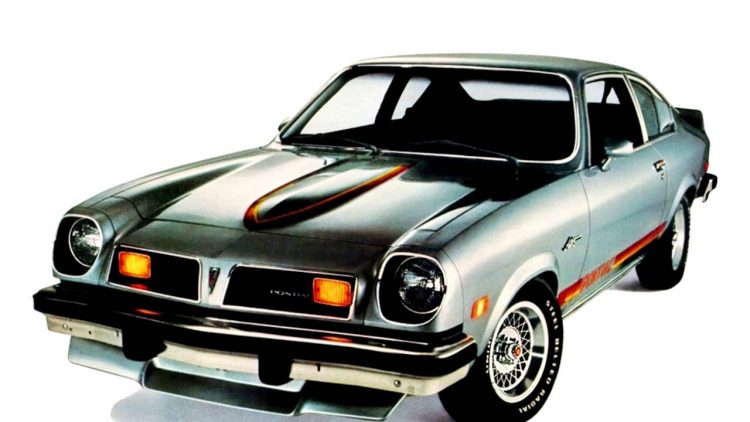
Few people today will remember the Pontiac Astre, let alone the one year only Lil’ Wide Track special offering. It was one of the rarest cars manufactured by General Motors in the 1970s! Subcompact was a rebadged Chevrolet Vega which doesn’t really speak in Astre’s favor. Still, Pontiac was probably glad they had something small and fuel-efficient to sell between 1975 and 1977 when oil embargo and new emissions regulations shook the very foundations of the U.S. car market. Lil’ Wide Track was offered during 1976 model year with aim to boost Astre’s low volume sales.
Around 3,000 of these customized subcompacts were built in total. Motortown Corp of Detroit was called upon to do the job. Final product was priced slightly north of $400 and included a number of unique styling touches. Lil’ Wide Track had louvered windows, an assortment of tape stripes across the body, Motortown wire mag wheels, rear spoiler, and a chrome exhaust tip.
Throughout most of Astre’s run, subcompact offered a single engine choice. Lil’ Wide Track too came with Dura-Built 140 cu in 2.3L 4-cylinder capable of making 87 horsepower. Astre Lil’ Wide Track was neither quick nor especially captivating, but at least it offered some pizzazz to a drab and anemic classic Pontiac subcompact.
1957 Star Chief Custom Safari Transcontinental
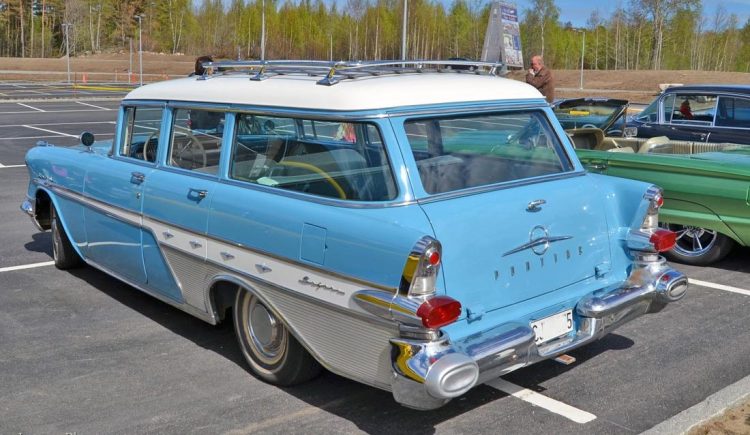
Star Chief used to be Pontiac Chieftain’s top trim package back in the day. Easily recognized by their rear side chromed stars, Star Chiefs sported extended A-body platform and somewhat larger powertrains then their Chevy counterparts. Star Chief Custom Safari Transcontinental was a special edition station wagon which debuted alongside Star Chief Custom Bonneville in 1957.
Safari nameplate was exclusive for 2-door station wagons prior to 1957 model year. Yet, Transcontinental was a 4-door car. Luxurious and expensive one at that. Starting at $3,636 back in the day, Pontiac’s forgotten wagon sported chromed roof rails and bumpers, leather interior, reclining bench seats, optional power windows, and many other goodies usually not found in lower priced Safaris.
Total production stopped at 1,894 models, but that’s only half the story. Transcontinental was introduced mid year so it wasn’t exactly given a fair chance. Still, Safari Transcontinental easily outsold its 2-door counterparts, despite the obvious handicap. For some reason (read new Bonneville), Pontiac decided to discontinue the Transcontinental and never use the nameplate again. Thus ended rather short story of this obscured yet stylish and exciting finned station wagon.
1985-1989 Sunburst

You’ll likely have to dig deep in order to remember the Pontiac Sunburst. How Does the Isuzu Gemini sound? Or the Chevrolet Spectrum, for that matter? As you now likely remember, Sunburst was just a rebadged version of the aforementioned Japanese subcompact limited to Canadian market. That probably makes it one of the least collectible and most forgotten classic cars Pontiacs ever made.
But Sunburst wasn’t a bad car. It provided Pontiac with much needed affordable efficiency alongside providing GM with alternative to Chevrolet Spectrum. 1.5L engine provided Sunburst with respectable 70 horsepower. Respectable considering subcompact only weighted around 2,000 pounds. Furthermore, Sunburst provided some sort of excitement after generally uninspiring malaise era offerings. However odd that might sound.
Finally, Gemini, Spectrum and Sunburst – being one and the same car – were all designed by none other than Giorgetto Giugiaro. However, GM tweaked his design in a number of ways. Enough to insult the great artist and spoil fruitful Isizu/Giugiaro relationship. It went as far as Giugiaro denying he had anything to do with the car years after GM’s captive import was discontinued.
2006-2009 Torrent
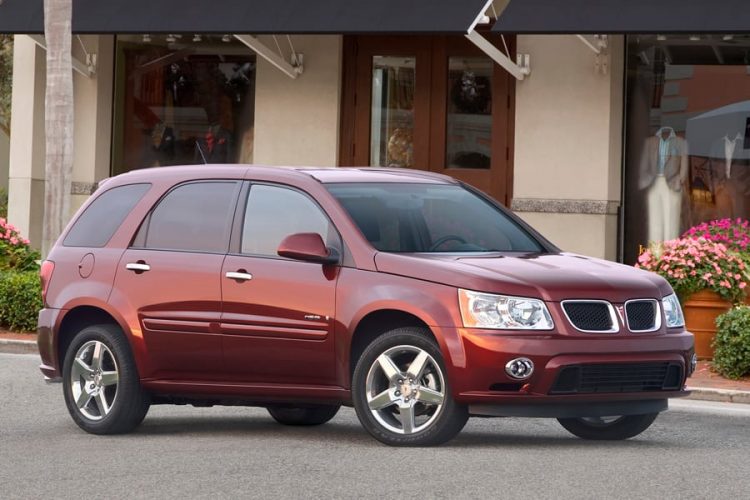
Only one question comes to mind with the Pontiac Torrent. Did enough time pass in order for us to forget it completely? Can it really be considered a classic Pontiac already? The answer is; likely not. Torrent is still rather fresh in many people’s memories. Plus, it isn’t exactly rare. Pontiac made more than 100,000 of them. But infamous Pontiac Aztek’s successor was, kind of, doomed from the get-go. Pontiac was already on its knees upon Torrent’s introduction in 2006. That’s one thing. The other is the fact it would always be known as Aztek’s successor.
Yet, unlike the Aztek, Torrent was one sharp looking mid-size crossover. Much prettier than its Chevrolet Equinox counterpart. One of their weaker sides was Chinese-sourced 3.4L V6 engine capable of producing only 185 horsepower. At least sportier Torrent GXP offered in 2008 and 2009 provided 264 ponies via home-built 3.6L V6.
The thing is – although still relatively young – the Torrent faded into obscurity the moment Pontiac disappeared. Focus shifted to the brand itself, and to some former successful models that bring back sweet memories. Even if Torrent was the best Pontiac vehicle in decades, people would have forgotten it due to this unfortunate turn of events.
1969 Custom S
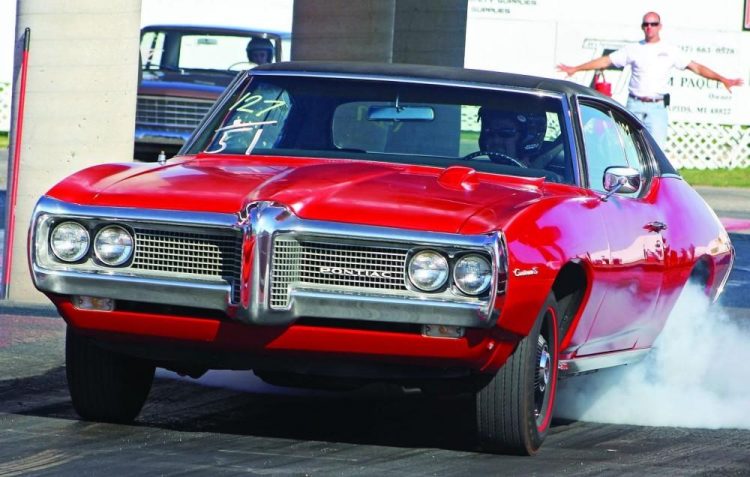
GT-37 isn’t the only obscure Pontiac A-body intermediate. For one year only, arrowhead brand offered the Custom S – replacement for the Tempest Custom. It slotted between the Tempest and the LeMans trims in terms of pricing and available amenities. After Pontiac discontinued Custom S, it was LeMans who had absorbed its 6 body styles.
Unlike the above mentioned GT-37 which arrived a year later, Custom S never offered GTO’s large displacement engines. Custom S had to be content with 4-barrel 350 cu in V8 HO churning out as much as 330 horsepower. Pushrod version of the engine delivered 265 ponies, while base 250 cu in straight-six generated 175 hp in conventional form or 230 hp with the Sprint package.
Much like the GT-37, Custom S too was supposed to tackle the Plymouth Roadrunner. Maybe that’s the reason Pontiac discontinued it after only one year. Come to think of it, they really took their sweet time offering that affordable supercar. By the time they finally did it, muscle car era was done for. That’s what happens when you dally with any particular idea. These beautiful old Pontiac cars are seldom remembered.
1977 Can Am
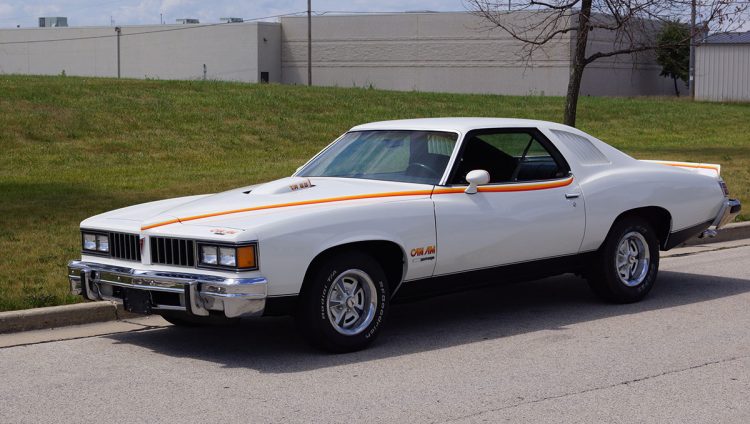
By the time seventies entered their latter part, the Pontiac GTO was already gone. First it lost its spot as a separate model, being optional package on LeMans for 1972 and 1973. Then it migrated to Pontiac Ventura in 1974, only to completely disappear from the scene towards the end of that year. But Pontiac quickly figured out they lost a great deal by axing GTO. So they desperately started looking for a replacement. Pontiac Can Am – special performance package for LeMans – answered their prayers.
Can Am sported 400 cu in V8 engine with 4-barrel carb setup and healthy (at the time) 180 horsepower. It also added 325 lb-ft of torque to the mix. However, California and high altitude regions received slightly different setup. They were supplied with Oldsmobile 403 cu in 4-barrel V8 producing corresponding horsepower output and 5 lb-ft of torque less than Pontiac’s V8. Both engines, however, were tied to Turbo-Hydramatic transmission since no manual was offered.

Being a special edition vehicle, Pontiac employed Motortown’s services in order to give Can Am much needed flair. In what was then known as “interrupt shipping,” Can Am’s were first assembled at Pontiac’s plant, given Cameo White paint, rear quarter window louvers, and white Rally II wheels, and then sent Motortown’s way. After Can Am’s received shaker hood, stripes and 1976 Grand Am’s spoiler there, they were sent back and distributed to Pontiac dealerships. Pay attention to that spoiler bit as that’s the exact reason Can Am’s never saw 1978. Or any model year after 1977, for that matter.
Rear spoiler tooling at Motortown broke down and Pontiac couldn’t wait three months for a new unit. So they cancelled the car after only 1,377 were made. Even though planned production was 5,000 units, and around 10,000 people lined up pre-ordering the car. Pity, really, because performance car in non performance era marketed by Jim Wangers could have become Pontiac’s new GTO.
1964-1967 2+2

Pontiac 2+2 started out as an option package on B-body Catalina in 1964. It was still an option package for Catalina the following year, but Catalina part of the name was removed by then. Preparation for 1966 when 2+2 became a model of its own. However, 2+2 reverted to being a simple Catalina option package for 1967 after which it was discontinued in the U.S due to poor sales. It soldiered on until 1970 in Canada, though.
Sharing the same platform with other Pontiac’s full-size cars, it was only expected 2+2 would offer the same engines as well. And it did. For 1964, lineup consisted of 389 cu in V8 and 421 cu in V8. Latter remained the sole option until 1967 when 360-horsepower 428 cu in V8 replaced it. HO version of the engine was available as well, and it developed 376 ponies.
Big brother to the Pontiac GTO didn’t only offer a host of performance and handling features like tri-power carb setup, heavy-duty suspension or dual exhaust with resonators, but it also added special styling touches such as unique badging, chrome dress-up engine kit, and full car length metal trim. All said and done, 2+2 is one obscure Pontiac that definitely deserved better marketing which would allow it to fulfill its true potential.
1973-1975 Grand Am

The Pontiac Grand Am – coined from two of the most popular classic Pontiac nameplates, the Pontiac Grand Prix and legendary Pontiac Trans Am – is far from obscure. As far as forgotten Pontiacs go, there are better candidates than Grand Am which appeared in three instances. Last one lasting for as much as 20 years between 1985 and 2005. But first two generations only lasted for three model years. With first one being one of the worthiest intermediate cars Pontiac could have wished for back then.
LeMans derivative (like most Pontiac’s post-1971 intermediates), Grand Am was supposed to delivered impressive performance complemented by corresponding refinement. As far as early seventies standards go, it did. Basic 400 cu in V8 delivered 170 hp, 200 hp or 230 hp depending on carburetor and exhaust setup. Stronger 455 cu in V8 produced 250 ponies. All Grand Am’s were tied to TH-400 trans with 4-barrel 400 cu in being available with optional 4-speed stick. By the time 1975 had arrived, however, all the aforementioned figures got reduced due to lower compression ratio. Sales followed the same pattern since 43,136 1973 Grand Am’s translated into 10,679 units for 1975.
The Grand Am required extensive overhaul for 1976 which Pontiac couldn’t justify with such low sales. Hence Grand Am got axed for the first time. Although it featured interesting options like mahogany instrument panel, steering wheel with brushed-stainless spokes, power windows, and concealed windshield wipers among others, Grand Am never threatened its A-body counterpart, the Oldsmobile Cutlass Supreme.

